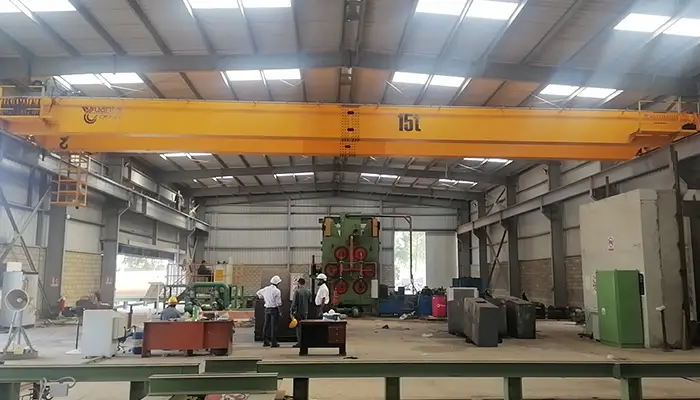
Why Variable Speed Control is Essential for Your Overhead Bridge Crane
Variable speed control enhances precision, improves load handling, reduces wear, and increases safety for overhead bridge cranes, optimizing operational efficiency.
Overview of Variable Speed Control
Variable speed control is a technology that allows operators to adjust the lifting speeds of overhead bridge cranes based on the specific requirements of a task. Unlike fixed speed systems, which operate at a constant pace, variable speed control offers flexibility by enabling smoother acceleration and deceleration. This capability is essential for managing different loads and enhancing overall operational efficiency.
In industrial applications, the significance of variable speed control cannot be overstated. It empowers operators to handle loads with greater precision, which is particularly crucial in busy environments where safety and efficiency are paramount. By allowing for tailored speed adjustments, operators can navigate tight spaces, avoid obstacles, and ensure that loads are placed accurately. This adaptability not only improves productivity but also minimizes the risk of accidents, making variable speed control a vital feature for modern overhead bridge cranes.
Importance of Speed Control for Load Handling
Enhanced Precision in Load Handling
Variable speed control significantly enhances precision in load handling by allowing for smoother and more gradual movements. When operators can adjust the speed, they can carefully position loads without the jerky motions that often come with fixed-speed systems. This smoothness is crucial in busy work environments, where there may be obstacles or sensitive equipment nearby. Accurate placement reduces the risk of damaging the load or surrounding structures, ensuring a more efficient workflow.
Adaptability to Different Loads
Every load has unique characteristics, including weight, size, and shape. Variable speed control enables operators to adapt their approach based on these factors. For instance, heavier loads may require slower speeds to maintain control, while lighter loads can be moved more quickly. This flexibility is particularly beneficial in industries like manufacturing and warehousing, where diverse load types are common. By tailoring the crane's speed to the specific task, operators can enhance productivity and ensure that materials are handled safely and effectively.
Improved Safety Measures
One of the most critical advantages of variable speed control is its contribution to improved safety. By allowing operators to manage speeds, the risk of accidents is significantly reduced. For example, when lowering heavy loads, a controlled descent can prevent sudden drops that might lead to injuries or equipment damage. Case studies have shown that workplaces using cranes with variable speed controls experience fewer incidents during load handling. These improvements are not just anecdotal; they are backed by data showing enhanced safety compliance and reduced workplace hazards, making variable speed control an essential feature for any overhead crane system.
Comparison of Fixed vs. Variable Speed in Operations
Overview of Fixed Speed Systems
Fixed speed systems are designed to operate at a single, predetermined speed. This simplicity makes them easy to use, especially in straightforward applications where loads are consistent and predictable. However, the limitations of fixed speed systems become apparent in dynamic work environments. Their lack of flexibility means they cannot easily adapt to varying load types or operational demands, often resulting in inefficiencies and increased wear on equipment.
Advantages of Variable Speed Systems
Variable speed systems, on the other hand, offer significant advantages over their fixed-speed counterparts. The primary benefit is adaptability; operators can adjust speeds based on the specific load and task at hand. For example, when lifting a delicate item, a slower speed allows for careful handling, whereas faster speeds may be suitable for moving heavier loads quickly. In scenarios like busy manufacturing floors or construction sites, variable speed systems shine by providing greater control and efficiency, reducing the risk of accidents and enhancing overall performance.
Operational Efficiency
When it comes to operational efficiency, variable speed systems excel in productivity. They allow for fine-tuning of lifting operations, which can lead to faster project completion times. Furthermore, because these systems can adapt to the task, they minimize operational downtime—crucial for maintaining workflow continuity. In contrast, fixed speed systems may lead to more frequent stops or slowdowns, resulting in higher overall downtime. A comparison of operational metrics reveals that facilities utilizing variable speed control experience smoother operations and significantly reduced interruptions, ultimately driving greater productivity.
Educating Users for Informed Choices
Importance of Understanding Crane Features
When investing in an overhead bridge crane, understanding its features—particularly speed control—is crucial. Potential buyers should recognize that variable speed control significantly impacts load handling and operational efficiency. By prioritizing this feature, users can enhance their productivity and safety in the workplace. Assessing the operational needs of their specific environment involves evaluating the types of loads they typically handle, the required lifting precision, and the overall workflow dynamics. By doing so, buyers can make informed decisions that align with their unique operational challenges.
Guidance for Selection
Choosing between fixed and variable speed cranes requires careful consideration of several key factors. Firstly, potential buyers should evaluate their typical lifting tasks. If their operations involve a diverse range of loads and require precise positioning, variable speed systems are likely the better choice. Additionally, it's important to consider the available space and the specific requirements of their work environment.
When discussing options with manufacturers or suppliers, buyers should ask about the adaptability of the crane's speed control features. Questions about customization, safety protocols, and post-sale support can provide deeper insights into how well a crane will meet their needs. Ultimately, an informed choice not only enhances operational efficiency but also contributes to a safer work environment.
Conclusion
In summary, variable speed control is a critical feature for overhead bridge cranes that enhances precision in load handling, adapts to various load types, and improves overall safety. By allowing operators to fine-tune lifting speeds, variable speed systems facilitate smoother movements and reduce the risk of accidents in bustling industrial environments. The adaptability and operational efficiency offered by these systems make them a valuable investment for any facility looking to optimize performance.